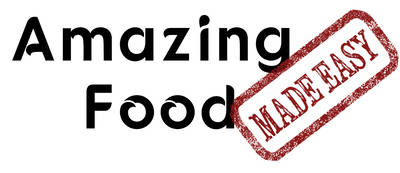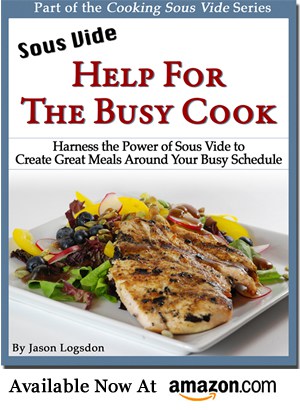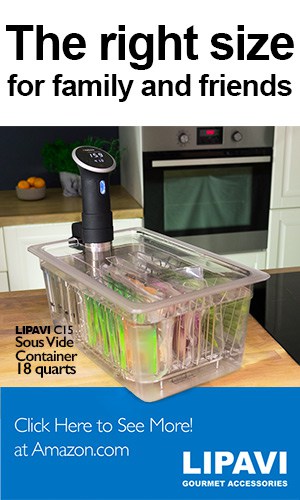-
Sous Vide Time and Temperatures
Sous Vide Time and Temps
Sous Vide Time and Temps
Sous Vide Temps
- All Sous Vide Temperatures
- Sous Vide Beef Temperatures
- Sous Vide Chicken Temperatures
- Sous Vide Duck Temperatures
- Sous Vide Fish Temperatures
- Sous Vide Vegetables Temperatures
- Sous Vide Infusions Temperatures
- Sous Vide Lamb Temperatures
- Sous Vide Pork Temperatures
- Sous Vide Shellfish Temperatures
- Sous Vide Turkey Temperatures
- Recipes Recipes Recipes Recipes
- Getting Started Guides Getting Started Guides Getting Started
- Equipment and Tools Equipment and Tools Equipment Equipment and Tools
- More Resources More Resources Resources More Resources

This article is a part of my free Exploring Sous Vide email course. If you want to discover how to consistently create amazing food using sous vide then my course is exactly what you're looking for. For a printed version of this course, you can purchase my Exploring Sous Vide cookbook.
Recommended Sous Vide Equipment
Click here to get great sous vide content via email
This post may contain affiliate links. Read more.
Written by Jason Logsdon
I get a lot of questions about what type of equipment is needed for sous vide. While you can do short sous vide cooks using nothing but a pot, a thermometer and a stove, there are several pieces of equipment that make sous vide much easier. There are 3 areas of sous vide equipment, sealing the food, heating the water, and searing the food and I'll give you my recommendations for each.
Note: If you prefer, you can jump right to the Lesson Recap.
My best-selling Modernist Cooking Made Easy: Sous Vide also explores these items in much more detail.
Sealing Sous Vide Food
Even though "sous vide" means "under vacuum", the only important part of sealing your food is to remove as much air as possible. This allows the water to come into closer contact with the food which transfers the heat more efficiently. There are several ways you can accomplish this.
Ziploc Freezer Bags and Sous Vide

The first and easiest way to seal your food is to simply use Ziploc freezer bags. This is what I use for most of my cooks because they are really easy to use and there's not a machine there to take up space. You can use the "water displacement method" to get the air out and you are good to go.
Using the "freezer" bags ensures that the bags hold up well to the higher temperatures used in sous vide.
Vacuum Sealers
For a tighter seal on your food, many people turn to vacuum sealers. These come as either edge-sealers like the FoodSaver brand or a chambered vacuum sealer like the Vacmaster. These can be great to use if you already own one or if you do a lot of food storage, though you don't need them to get started. As I said, I generally use Ziploc bags for all my cooking.
Note: For more information about sealing, you can read my article on the best way to seal food for sous vide.
Heating Water with Sous Vide

The most critical piece of sous vide equipment is the device that heats your water. There's lot of different types of machines but I generally recommend a sous vide circulator. They are relatively inexpensive now (under $200) and there are several options.
After testing most of the ones available I now use the Sansaire because it is a little quieter than the others (important in a small NY apartment) and heats slightly faster (important when it takes 15 minutes for your facuet to heat up). My Dad has settled on the Anova and that is also what my mother-in-law uses. Many people also use the Gourmia Sous Vide Pod, which also comes with a booklet of my recipes.
We all use them with a Cambro 12 quart container to hold the water. And have cut a lid to prevent evaporation.
Note: I have a ton more information about sous vide machines including a detailed sous vide benchmark test comparing 7 different sous vide machines and a look at how long it takes a sous vide machine to heat up and how much energy sous vide uses.
Searing After Sous Vide
There are many ways to sear your food after you have finished cooking it with sous vide. If you are just getting started out, go ahead and just pan fry your food. It's the cheapest method since you probably already have a pan and a stove. Many people rave about using cast iron pans as well.

I personally use a BernzOmatic torch to sear my food. It works more quickly than the stove, results in less over cooking, and has less clean up.
Note: For more information you can read my guide to sous vide searing.
Is there any specific sous vide equipment you've really enjoyed? Have some specific questions you need answered? Let me know in the comments or on the Exploring Sous Vide Facebook group.
Exploring Sous Vide Lesson Recap
In this lesson we discussed the equipment that will help you successfully cook sous vide. This included ways to seal the food, heat the water, and sear the food.
Recommended Sous Vide Equipment
My recommendations for sous vide equipment were:
- For sealing you can use simple Ziploc bags, a FoodSaver sealer or a chambered vacuum sealer like the Vacmaster.
- For heating the water I use a Sansaire and my extended family uses an Anova.
- To hold the water we use a Cambro 12 quart container with a lid to prevent evaporation.
- For searing you can use your stove, preferably with a cast iron pan. Now I usually use a BernzOmatic torch.
I also shared some key links with you, namely
- How to use the water displacement method
- My best-selling Modernist Cooking Made Easy: Sous Vide
- My look at the best way to seal food for sous vide
- More information on sous vide machines including a detailed sous vide benchmark test comparing 7 different sous vide machines, how long it takes a sous vide machine to heat up, and how much energy sous vide uses
- My Guide to sous vide searing
Do you know anyone that is struggling with sous vide and would find this information helpful? Why not do them a favor and send them a link to this Exploring Sous Vide email course or get them a printed version of this course!
Course Link:
 Thanks again and happy cooking!
Thanks again and happy cooking!
Jason Logsdon, Amazing Food Made Easy
This article is a part of my free Exploring Sous Vide email course. If you want to discover how to consistently create amazing food using sous vide then my course is exactly what you're looking for. For a printed version of this course, you can purchase my Exploring Sous Vide cookbook.
 This article is by me, Jason Logsdon. I'm an adventurous home cook and professional blogger who loves to try new things, especially when it comes to cooking. I've explored everything from sous vide and whipping siphons to pressure cookers and blow torches; created foams, gels and spheres; made barrel aged cocktails and brewed beer. I have also written 10 cookbooks on modernist cooking and sous vide and I run the AmazingFoodMadeEasy.com website.
This article is by me, Jason Logsdon. I'm an adventurous home cook and professional blogger who loves to try new things, especially when it comes to cooking. I've explored everything from sous vide and whipping siphons to pressure cookers and blow torches; created foams, gels and spheres; made barrel aged cocktails and brewed beer. I have also written 10 cookbooks on modernist cooking and sous vide and I run the AmazingFoodMadeEasy.com website.
Affiliate Disclaimer: Some links on this site might be affiliate links that if used to purchased products I might receive money. I like money but I will not endorse something I don't believe in. Please feel free to directly go to any products I link to and bypass the referral link if you feel uncomfortable with me receiving funds.













